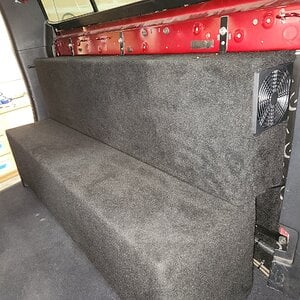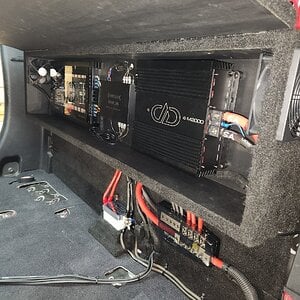As far as the technical aspect, it breaks the magnetic gap into more than one region, meaning instead of a typical motor that has a single high flux gap in the center, there are two or more gaps in the motor that have narrower high flux regions. Then, the coil is sized to optimize BL over the curve, mainly so that the coil will extend from the center of the top gap to the center of the bottom gap, that way when it leaves one high flux region, it enters the other. Most subwoofers use the voice coil to achieve a higher excursion, the downside of that is that the higher the excursion, the less coil is in the gap, so you lose motor strength and control, so distortion is increased and overall BL is decreased. Adire's method uses the gap more effectively and distributes it over a shorter coil, while decreasing required top plate length, thus the production cost. Coil length is decreased compared to designs like overhung and evenhung, so inductance is less and transient performance and efficiency is better. It's one of the best, if not the best motor design out there.
BTW, the main benefit of this topology isn't fully realized with subwoofers. This actually sees more benefit with midbasses, midranges, tweeters, and full range drivers. Typically, and XBL^2 driver will still only have 30% of the distortion other designs have at 70% of maximum linear excursion (x-max). In many cases, this translates to around a 1% distortion rating at 70% excursion, while others are between 3 and 5%. This allows a design that yields very clean sound at higher volumes and can fully realize the potential of enclosures such as sealed and infinite baffle, where excursion is naturally higher and SQ tends to suffer at high volumes due to that.
The biggest benefit of XBL^2 is that it allows a smaller driver to have higher output levels and a wider bandwidth, meaning a 6" midbass driver could potentially have the depth of a typical 8" driver and rival some 10" drivers for depth, and be very linear and accurate doing it. Their Extremis midbass driver is a good example of this, it is a 6.8" driver having a 13mm one way X-max, only a .13mH inductance, and is ideal for ported boxes tuned in the 30s, offering in-room extension down to the 20s. Inductive rolloff occurs around 8khz and there are no nasty breakup modes from the cone, crossover will typically be 2-3khz. To give you an idea, the Scan-Speak Revelator and SEAS Excel drivers, which are renowned high end home audio drivers, have a good bit more inductance, right at half or less than half the excursion level, less motor strength, and less bandwidth. As their designs progress even further, Adire is going to be a very difficult manufacturer to beat, or even level with for that matter.
Apocalypse, think about a magnet reacting to another magnet. The most strength will naturally occur when the magnets are closest together, and become weaker as they move further away. Similarly, in the case of a speaker, you have a fixed magnet and the voice coil, in which the coil is an electromagnet. They will either repel or attract each other with current applied. With a typical speaker, the center point of the motor (permanent magnet) is where the strength is focused, and at rest, the voice coil is centered in that. As current is applied, forces either repel or attract this, moving the coil up or down. As you can imagine, as it moves, less and less of the voice coil is retained within the gap, so magnetic control over the entire voice coil is reduced. The idea with these motor designs is that the longer the coil, the more there is to apply strength to, so you'll get more excursion with a longer coil. XBL^2, from a functional standpoint, has two or more points that focus strength over a narrower gap, just think of it as two magnets, and as the coil leaves one gap, it will enter another, which allows a higher level of control and motor strength than if it were one. As the coil moves further from one gap, it moves closer to the other, so you will have more control over the coil since you are always within a strong point of flux, and you will get more motor strength over the excursion limitations.
About efficiency, XBL^2 is actually more efficient than most motor designs out there overall, it is the soft parts that tend to bring down the efficiency of the subs they are used in. Adire uses epoxy treated paper cones in their subs, which are heavier than many other materials, but chosen for their damping ability, they also use a wider profile surround as opposed to a taller one, which controls the subwoofer very well, but cuts down surface area, and tighter suspension designs than many. XBL^2 isn't really the reason a Brahma isn't as efficient than other subs, but rather the reason it isn't less efficient than it already is. Adire is also more true with their sensitivity specs than many other manufacturers. Remember as well, that sensitivity specs are very misleading and give no clue to how loud a subwoofer will be at higher volumes. Excursion is low at 1 watt , a subwoofer with a parabolic BL curve will do well at 1 watt, but lose motor strength (thus efficiency) at higher volumes. XBL^2, on the other hand, offers flat BL and will give more BL at higher volumes than many other motor designs, making it more efficient with the power.











